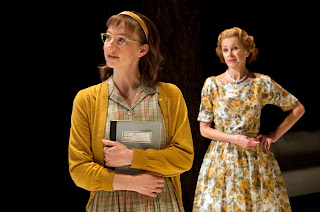As Artistic Director of Why Not Productions, and director of the current Tarragon production, Ravi Jain has found a spectacular, one of a kind co-creator who graces the stage with tremendous composure, sweetness, and generosity of spirit. Seated for the entire performance, Asha Jain represents a frequently serene oppositional force in the face of her son's lively and relentless desire to make his own choices. At times Ravi seems to almost parody his mother's logic as she articulates her very detailed beliefs regarding marriage and family. When the son wryly declares, "who can argue with logic like that," in the face of his mother's circuitous narrative route, it is obvious that the two family members have belief systems based in profoundly different structures regarding religion as it relates to 'God' and family. The word 'God' is used at least twice in the script and resonates with a powerful sense of how logic and spirituality works for many people.
A very poignant moment occurs when Asha re-tells the story of a life dream that took a rather unexpected route and landed her in a very "foreign" snowy environment - Canada. This is an immigrant story that has been placed within a kind of hybrid performance site developed through improvisational structures and then tightly scripted into 90 minutes of sheer entertainment and moving testimony - and the fourth wall is deliciously shattered at the outset as warm samosas are shared with spectators before and after the show.
Typical of great theatre - and theatricality - an awkward form of very thought provoking laughter emerges from time to time when the parody from Ravi's physically manic side of the coin tends to make it difficult to know whether his mothers views are being laughed with or laughed at. But as Asha tells her son, "We are two sides of the same coin." This concise cliche works beautifully as audiences take an up close and personal journey with two very talented storytellers who may seem at loggerheads when in fact they are simply trying to fit their world views into their immense love for each other.
for further information on Why NOT THEATRE and A Brimful of Asha go to
http://theatrewhynot.org/brimful/
A Brimful of Asha
published by Playwrights Canada Press
A Brimful of Asha
published by Playwrights Canada Press
















